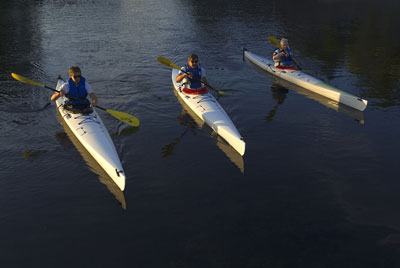| Posted: August 13, 2010 |
Carbon nanotubes making waves in kayak design |
|
(Nanowerk News) Baytubes®, the carbon nanotubes from Bayer MaterialScience, are now making waves in kayak design, marking a new chapter in the evolution of these popular boats, which were originally made by the Inuits using wood, bone and animal skin. Today's kayaks are usually made from plastics and composite materials. Some new kayak prototypes have now been coated with an epoxy gelcoat modified with Baytubes® that has been developed by Norwegian research company Re-Turn AS, based in Gamle Fredrikstad. "We are confident that these prototypes outperform standard models in a number of areas," explains Stein Dietrichson, General Manager of Re-Turn AS.
|
|
Reinforcing the outer skin of a kayak – the gel coat – with carbon nanotubes makes it far more resilient to abrasion from a shingle beach or contact with the edge of a river bank. In contrast, many conventional gel coats, especially those of particularly lightweight and sporty kayaks, are highly sensitive to external mechanical action. But that isn't the only way that these tiny tubes in the solvent-free gel coat help to prolong enjoyment of the boat and therefore of the sport itself – they ensure that cracks appear less frequently over long-term use and reduce wear on the outer skin. They also absorb UV radiation, thereby minimizing the associated bleaching and embrittling effects.
|
 |
| Some new kayak prototypes have now been coated with an epoxy gelcoat modified with Baytubes® that has been developed by Norwegian research company Re-Turn AS, based in Gamle Fredrikstad. Thanks to the carbon nanotubes the outer skin of the kayak is more abrasion-resistant. They also ensure that cracks appear less frequently over long-term use. The picture shows Stein Dietrichson, managing director of Re-Turn, Paal Francis Hansen, chairman of the board, and a trainee during a trial run (from right to left).
|
|
Re-Turn AS modified the outer shell of one of the prototypes with Baytubes®. "This means that the kayak doesn't get as dirty above or below the water line and is easier to clean," states Dietrichson. And he hopes that this innovative combination will result in another effect: "The flow resistance of the hull should also be lower."
|
|
This will enable the kayak to glide through the water faster without its occupant having to paddle harder – a fantastic advantage for any aspiring kayaker. And there are further advantages to the use of carbon nanotubes in the epoxy base of the kayak, which the additive helps to make more stable and rigid. "This makes the boat easier to paddle and translates more of the kayaker's muscle power into speed. The new gelcoat incorporates many experiences from the development of nanotubes reinforced marine paints which are already commercial," comments Dietrichson.
|
|
During this summer, experienced kayakers will be putting the prototypes from Re-Turn AS through their paces. Meanwhile, experts from the Norwegian company are already working closely with Bayer MaterialScience to develop further nanotube-reinforced materials that could in future find their way into kayaks or, for example, into the rotor blades for wind turbines.
|

